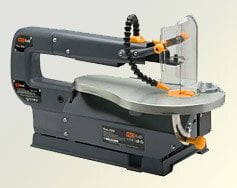An electric jigsaw is designed to make straight and curved cuts on various sheet materials and complex shaped workpieces, including without disturbing the outer contour. Jigsaws are most often used for cutting wood and wood panels, plastic blanks, parts with complex contours made of plasterboard and laminate as well as for cutting sheet metal.
Benchtop jigsaws are a stationary design, which is due to most of the advantages of this type of cutting tool. Modern models of desktop jigsaws are designed to work with wood materials 40-50 mm thick.
The working device is a narrow saw blade, which performs reciprocating movements in the vertical direction. At the same time, thanks to the peculiarities of the teeth notches and the mechanics of the saw’s movement, the cutting into the material takes place during the upward movement.
Advantages of bench-mounted jigsaws:
- high precision and accuracy of cuts;
- wide adjustment possibilities depending on the material and the required shape of cut workpieces;
- Increased safety and comfort of work.
The disadvantages of bench-mounted jigsaws include rather large dimensions and complexity of work with large workpieces.
Reasons for choosing a benchtop jigsaw
The choice in favor of buying a benchtop jigsaw is justified when you need to make clean cuts of complex shape and work with small parts. High cutting precision is achieved thanks to the stable and fixed position of the tool during work. Stability of the saw blade stroke is provided by the tensioning system and guides, which manual tools do not have.
The relatively large dimensions of the table result in a large support surface of the workpiece to be cut, and therefore greater stability and less deviation from the set sawing direction. To some extent, the desktop jigsaw is a mini-machine for cutting workpieces.
Some models of desktop jigsaws have the ability to select the power (e.g. Enkor Corvet jigsaw) supplied to the motor, as well as adjusting the frequency of saw strokes in the range of 500 to 1600 movements per minute (e.g. jigsaw DS 403 Vario).
As a rule, the design of the saw blade clamp allows it to be changed quickly, as well as to be set in one of several positions. The adjustable tilt of the table in relation to one or two axes completes the possibilities of cutting at an angle.
Many bench jigsaws are equipped with additional features, such as an angle stop with degree notches, a clear protective screen, and a blower system to keep the cutting area free of sawdust.
Read More: